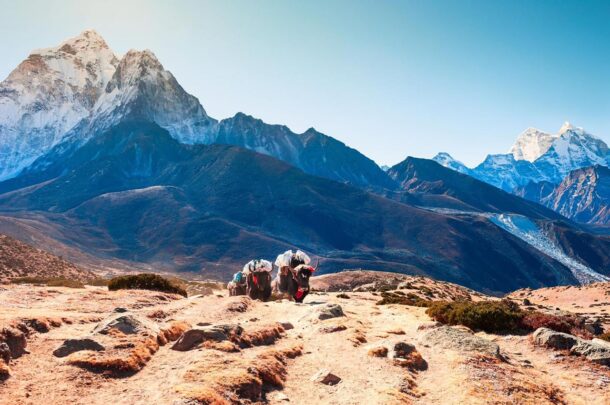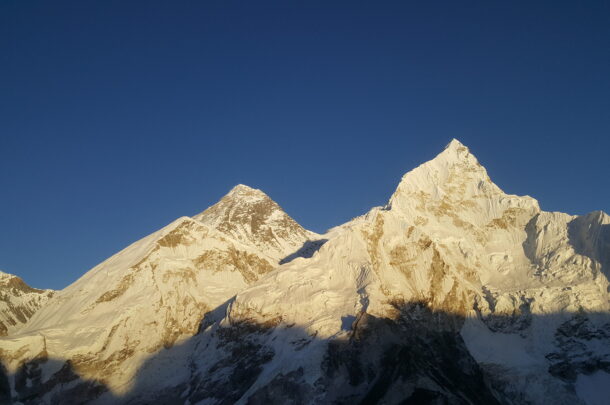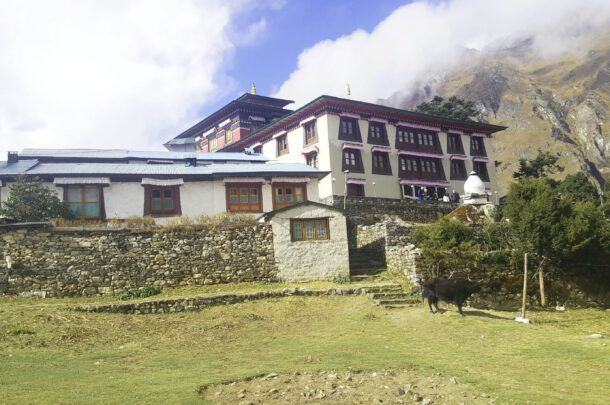Annapurna Base Camp Trek Vs Everest Base Camp Trek
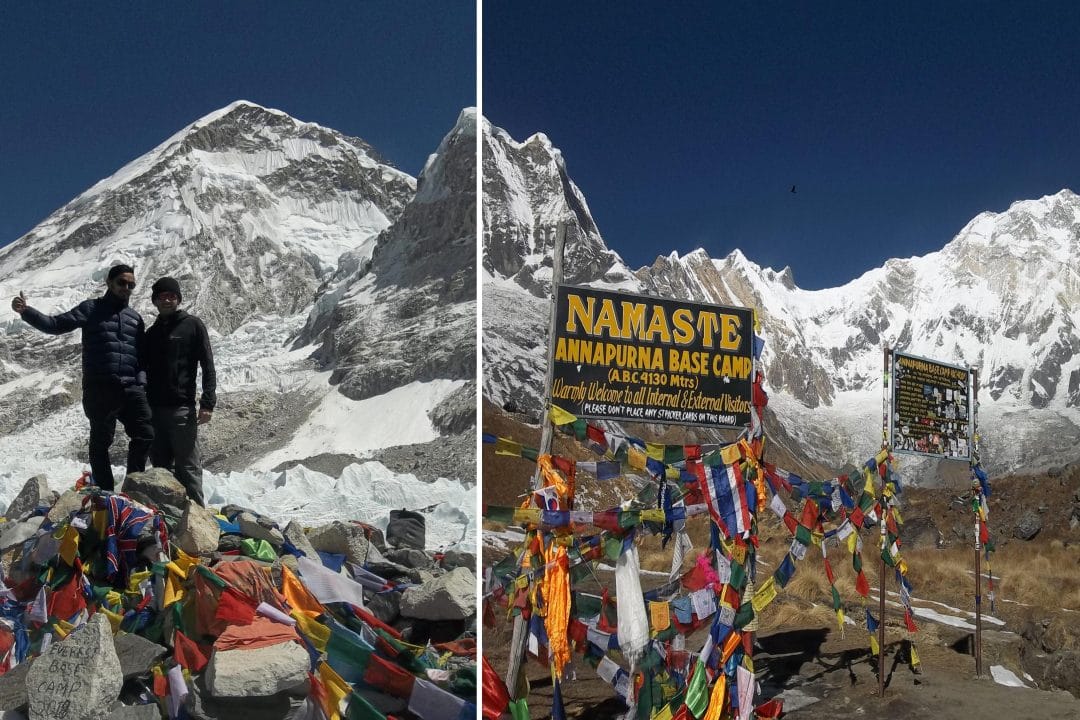
If you considering what the best trek in Nepal is then the Annapurna Base Camp trek VS the Everest Base Camp trek is something you might want to take a closer look at! While both the Annapurna Base Camp trek and the Everest Base Camp trek are excellent and stunning treks in Nepal, which trek would be better suited for you? In this blog about the Annapurna Base Camp trek VS the Everest Base Camp trek, High Route Adventure compares the essentials and differences between both treks such as; Himalayan views, itineraries, differences in altitude, permits, culture, location, the best time to trek and highlights! Have a look and if you still can’t decide, have a look at High Route Adventure’s unique trekking package the Annapurna Base Camp trek + the Everest Base Camp trek. With this special trek in Nepal, you’ll get to experience both treks in one holiday!
The Annapurna Base Camp VS the Everest Base Camp trek is one of the most asked questions when it comes to the best trekking routes in Nepal! Both treks are popular and booked every year by hundreds of trekkers and mountain lovers. So which one is the best trek in Nepal? Well in our eyes both of them are amazing, and should be done at least once a life! Let’s break them down.
Table of Contents
The Annapurna Base Camp Trek

The Annapurna Base Camp trek, located deep in the Annapurna Sanctuary in the southern part of the Annapurna Himalayan Range, is one of the most beautiful treks in Nepal! During the Annapurna Base Camp trek, you’ll pass through jungles, cross over rivers, and head further up until the terrain changes into a snowy blanket surrounded by mountains. Your target is the famous Annapurna Base Camp or in short ABC! The trekking trails of the Annapurna Base Camp trek are well maintained and easier going than the trails leading to Everest Base Camp. With different routes to choose one that can make the ABC trek longer or even shorter, this trek in Nepal is combinable with many other treks such as; the Mardi Himal trek, Khopra Ridge trek, and even all three combined.
The standard itinerary of the Annapurna Base Camp Trek:
| Day | Itinerary | Altitude | Meals | Accommodation |
| Day 01 | Arrival at Kathmandu and trekking preparation | 1,350m | Hotel | |
| Day 02 | Drive from Kathmandu to Pokhara | 820m | Breakfast | Hotel |
| Day 03 | Drive to Nayapul and trek to Tikhedhunga | 1,570m | Breakfast | Teahouse |
| Day 04 | Trek from Tikhedhunga to Ghorepani | 2,840m | Breakfast/Lunch/Dinner | Teahouse |
| Day 05 | Hike up from Ghorepani to Poon Hill (3210m) – 45 minutes, Trek to Tadapani | 2,620m | Breakfast/Lunch/Dinner | Teahouse |
| Day 06 | Trek Tadapani to Chhomrong | 2,140m | Breakfast/Lunch/Dinner | Teahouse |
| Day 07 | Trek from Chhomrong to Dovan | 2,500m | Breakfast/Lunch/Dinner | Teahouse |
| Day 08 | Trek from Dovan to Deurali | 3,200m | Breakfast/Lunch/Dinner | Teahouse |
| Day 09 | Trek from Deurali to Annapurna Base Camp (4130m) – 4 to 5 hours, via Machhapuchhre Base Camp (3700m) | 4,130m | Breakfast/Lunch/Dinner | Teahouse |
| Day 10 | Trek back from the Annapurna Base Camp to Bamboo | 2,345m | Breakfast/Lunch/Dinner | Teahouse |
| Day 11 | Trek from Bamboo to Jhinu Danda (hot spring) | 1,780m | Breakfast/Lunch/Dinner | Teahouse |
| Day 12 | Trek from Jhinu Danda (Hot spring) to Siwar to Nayapul drive to Pokhara | 820m | Breakfast/Lunch | Hotel |
| Day 13 | Drive back to Kathmandu | 1,350m | Breakfast/Dinner | Hotel |
| Day 14 | Departure | Breakfast |
This standard itinerary of the Annapurna Base Camp trek is consistent with 14 vacation days whereof 10 days will be spent trekking. As mentioned above this itinerary can be made shorter or longer by combining with other treks such as the Mardi Himal trek, and Khopra Ridge Trek. Average trekking hours per day are between 4 to 6 hrs. The trail goes mostly upwards with some descends and easily walkable tracks. If you would like to know more details regarding this trek, you can visit the package of the Annapurna Base camp trek.
The best time to do the Annapurna Base Camp Trek
What’s so unique about the ABC trek in Nepal is, that it can be done the whole year-round. Of course, there are those seasons when the Annapurna Base Camp trek is at its best in terms of weather, and views! The best time to do the Annapurna Base Camp trek is either in the spring season (March to May) just before the monsoon season (the rainy season in Nepal) or in the fall/autumn season (September to December). During these two seasons, the weather is quite comfortable and you’ll get to see those clear blue skies and white-capped Himalayan Mountains during the whole trek to and from ABC! Do keep in mind that during the fall/autumn season, the weather will be colder at night and you’ll have to organize your trekking clothes accordingly. If you choose to do the Annapurna Base Camp trek during the monsoon season in Nepal (June to August) High Route Adventure recommends good rain and waterproof clothes and long-piped pants.
During the other months, the Annapurna Base Camp trek can also be done but there are no guarantees that you’ll see the best views possible. So in short, to get the best experience of the Annapurna Base Camp trek you’ll want to either book it during the spring season (March to May) or during the fall/autumn season (September to December)!
Popular Mountain views during the Annapurna Base Camp Trek

Trekking, especially in the Himalayas is mostly to be able to see some of those incredible high mountains and peaks up close. During the Annapurna Base Camp trek, you’ll get your fair share of some of the highest mountains in the world! To make it easier for you High Route Adventure has made a shortlist of the most popular mountains that you can see during the Annapurna Base Camp trek.
- Mt Annapurna I (8,091m/26,545ft) ranked 10th highest mountain in the world
- Mt Annapurna II (7,937m/26,040ft)
- Mt Annapurna III (7,555m/25,158ft)
- MT Annapurna IV (7,525/25,058ft)
- Mt Annapurna South (7,219m/23,684ft)
- Gandharva Peak (6,248m/20,499ft)
- Tharpu Chuli (Tent Peak) (5,663m/18,580ft)
- Mt Dhaulagiri (8,167m/26,795ft) ranked 7th highest mountain in the world
- Mt Machhapuchhare (Fishtail Mountain) (6,999m/22,963ft)
- Mt Hiunchuli (6,441m/21,132ft)
- Mt Gangapurna (7,455m/24,459ft)
Of course, there are a lot of other mountains and peaks that can be seen during the Annapurna Base Camp trek. To see and know them all you’ll need to do the trek yourself and find out firsthand!
Location of the Annapurna Base Camp trek
Located just south of the Annapurna Himalayas the Annapurna Base Camp trek, is a south-to-north trek starting from the Gurung village of Gandruk and makes its way in a northwards direction to Annapurna Base Camp. The Annapurna region of Nepal lies in a northwestern direction from the capital Kathmandu and requires you to travel to Pokhara to start the trek. Pokhara is an amazing city located on the banks of Phewa Lake and surrounded by hills with Mt Machhapuchhare (the famous Fishtail Mountain) looking over the lakeside city. From Pokhara, it’s a short drive to Ghandruk via Nayapul from where the trek to ABC officially starts.
Max elevation during the Annapurna Base Camp Trek
When comparing the Annapurna Base Camp trek VS the Everest Base Camp trek, the maximum elevation during the trek places a big role. The Annapurna Base Camp trek has a max elevation of 4,130 meters or 13,545 feet at Annapurna Base Camp itself. This maximum elevation is a lot less than the Everest Base Camp trek’s 5,545 meters or 18,192 feet at Kala Pathar. Nevertheless, the maximum elevation of the Annapurna Base Camp trek is still high and absolutely worth it! While there is almost no chance to get AMS (Acute Mountain Sickness) during the Annapurna Base Camp trek due to its lesser elevations, we still take care to not increase in elevation too fast.
Permits for the Annapurna Base Camp Trek
In order to avoid overcrowding and to make sure there are funds to maintain and further develop the trekking regions in Nepal, most areas require permits to enter. These permits come always inclusive with any type of booking with High Route Adventure. But, they differ from region to region and so also differ for the Annapurna Base Camp trek and the Everest Base Camp trek. For the Annapurna Base Camp trek you’ll need two types of permits;
With these two permits, you can freely enter and explore the Annapurna Conservation Area. There will be a check-post along the route to Annapurna Base Camp that will check these permits, and if you do not have them, you will be refused entry!
Culture during the Annapurna Base Camp Trek
Culture plays a big role during any type of trek in a remote country. The cultural aspect of the Annapurna Base Camp trek is unique in its own way. While the area is populated by different ethnical groups, most of the population belongs to the Magar and Gurung castes. These extremely friendly and hospital people are masters in hill and high-altitude agriculture and have been living and thriving in the Annapurna mountains for many decades. With the Gurung’s biggest settlement Ghandruk, which is the starting point of the Annapurna Base Camp trek, you’ll quickly get used to and see their amazing culture and traditions. Also at Ghandruk is a local Gurung museum which you can visit. Depending on which season you’ll come to do the ABC trek in Nepal you might be there during a festival, which will make your cultural experience of the Annapurna Base Camp trek even more exciting! The most popular festivals in this region are the Dashain (October), Tihar (October-November), and Tamu Loshar (beginning of the New Year) festivals. As the dates always change every year, it’s best to check with our High Route Adventure travel team if you are planning a trek during a festival season!
Highlights of the Annapurna Base Camp Trek
As with every trek in Nepal, the Annapurna Base Camp trek has its own unique highlights that differ quite a lot from the Everest Base Camp trek. These highlights are what make the trek to Annapurna Base Camp so special. High Route Adventure takes great pleasure in summing up and short explaining these highlights of the Annapurna Base Camp trek;
Ghandruk Gurung village:
Ghandruk is the biggest Gurung settlement of the southern Annapurna Himalayas. This unique village is located at a height of 1,940 meters or 6,365 feet and is also the starting point of the standard Annapurna Base Camp trek. Directly accessible via ground vehicle from Pokhara, Ghandruk is also accessible via trekking from Ghorepani-Poon Hill by heading east via Tadapani. It is one of the most popular villages in the area as it lies on both the Ghorepani Poon Hill trek and Annapurna Base Camp trek trails.
Incredible fauna and flora:
Trekking to Annapurna Base Camp takes you through lush hilly jungles filled with pine and rhododendron trees. During the spring season, orchids and marigold flowers are in bloom turning the Annapurna Valley into a colorful picture. Wildlife is also not scared in the Annapurna region, from the common pheasant to the playful Lemur and Macaque monkeys, and from the Himalayan Black bear to the giant Himalayan honey bee, you’ll get to see a lot of fauna during the Annapurna Base Camp trek, even more than on the Everest Base Camp trek. Although very rare on a lucky day you might even see a glimpse of a leopard during the Annapurna Base Camp trek!
2 of the top 10 Highest Mountains in the World:
During the Annapurna Base Camp trek, you get to see incredible high mountains and peaks, whereof two of them are listed in the top ten highest mountains of the world! They are Mt Dhaulagiri (8,167m/26,795ft) ranked the 7th highest mountain in the world, and Mt Annapurna I (8,091m/26,545ft) ranked the 10th highest mountain in the world.
Caves and Waterfalls:
Along your journey to the Annapurna Base Camp, you’ll come across a lot of scenic waterfalls and mysterious caves! One famous cave along the way from Bamboo is an old meditation cave called the Hinku cave. Pay attention to this one and ask your guide if it’s possible to make a quick visit to this special cave to further increase your experience of the Annapurna Base Camp trek!
Annapurna Base Camp:
The main highlight of the ABC trek is obviously Annapurna Base Camp itself! Located at the highest point of the trek at 4,130 meters or 13,545 feet, the official name of ABC is actually Annapurna Base Camp South as it’s the southern base camp of the Annapurna Himalayas. Directly recognizable by its blue tin roofs, ABC is truly one of the most popular base camps in Nepal. Annapurna Base Camp is also directly accessible via a short helicopter flight from Pokhara, but this way although saving a lot of time skips all the unique parts of the trek itself!
Jhinu Danda hot springs:
Nearby the village of Chhomrong (2,170m/ 7,119ft), lays a smaller village called Jhinu Danda. This small village will be visited on the way back from Annapurna Base Camp, and has its own natural hot water springs! For a small fee (about. 100NRs) you can take a dip in those healing hot waters, and let your muscles recuperate from the trek. A great way to end a successful trek in the Himalayas!
With these specific highlights, the Annapurna Base Camp trek stands out from its counter trek the Everest Base Camp trek. But as with all treks, if you really want to experience it then just do it! Bookings for the Annapurna Base Camp trek in Nepal with High Route Adventure are the whole year and can be booked directly through the website.
The Everest Base Camp Trek:
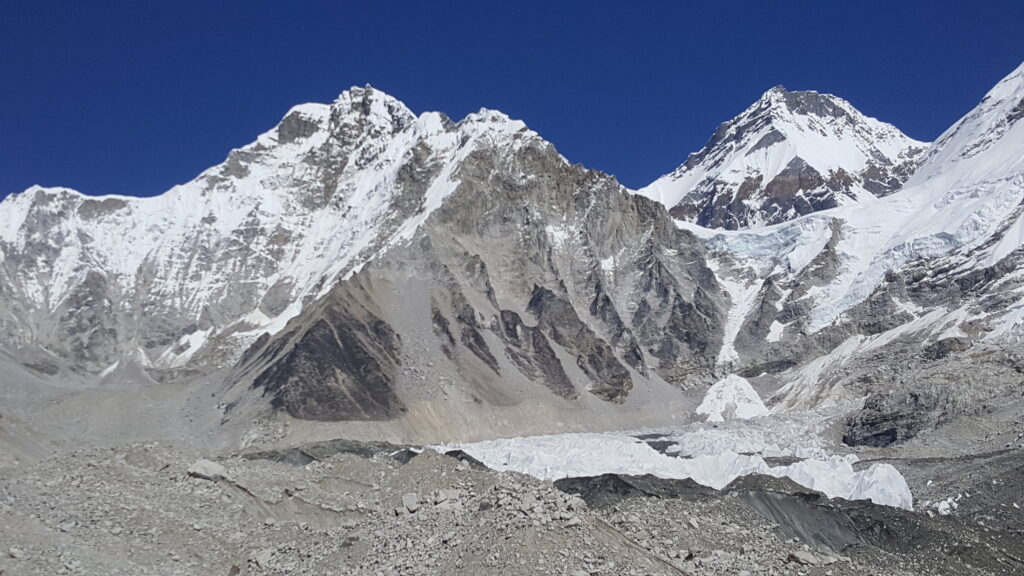
Known as one of the most popular treks in Nepal, the Everest Base Camp trek has been booked by many trekkers and mountaineers over the years. With a visit to the world’s most famous base camp, Everest Base Camp, and the guarantee to see some of the highest mountains in the world including the highest, Mt Everest, the Everest Base Camp trek offers it all in terms of high altitude trekking!
Compared to the Annapurna Base Camp trek, the Everest Base Camp trek has more trekking days and goes to higher elevations. This means that the Everest Base Camp trek is a bit harder to trek than the ABC trek. Furthermore as Everest Base Camp is one of the most popular base camps in a trekker’s paradise region, there are many other treks that lead to this base camp in Nepal. The fastest way by the trek is via the Everest Base Camp trek, but you can choose other treks also to visit EBC such as; the 3 High Passes Trek, The Gokyo Valley trek with the Cho-La Pass, The Everest Base Camp trek with Lobuche Peak, the Everest base camp trek with Island Peak or if you want the quickest way by air via the Everest Base Camp Helicopter tour! There are many other treks in the Khumbu (Everest) region of Nepal, which you can find out on our website under trekking in Nepal. High Route Adventure has made a carefully planned standard itinerary for the Everest Base Camp trek, which will be displayed below. Of course, this itinerary can be modified to be longer or even shorter, have a look!
The Standard Itinerary of the Everest Base Camp Trek:
| Day | Itinerary | Altitude | Accommodation |
| Day 01 | Arrival in Kathmandu | 1,400m | Hotel |
| Day 02 | Fly from Kathmandu to Lukla and Trek to Phakding | 2,610m | Teahouse |
| Day 03 | Trek from Phakding to Namche Bazaar | 3,440m | Teahouse |
| Day 04 | Acclimatization and Exploration Day at Dingboche | 3,440m | Teahouse |
| Day 05 | Trek from Namche to Pangboche | 3,990m | Teahouse |
| Day 06 | Trek from Pangboche to Dingboche | 4,410m | Teahouse |
| Day 07 | Acclimatization and Exploration day at Dingboche | 4,410m | Teahouse |
| Day 08 | Trek from Dingboche to Lobuche | 4,940m | Teahouse |
| Day 09 | Trek from Lobuche to Gorakshep, and Hike to Everest Base Camp | 5,164m | Teahouse |
| Day 10 | Hike to Kalapatthar (5,545m) and Trek from Gorakshep to Pheriche | 4,170m | Teahouse |
| Day 11 | Trek from Pheriche to Namche | 3,440m | Teahouse |
| Day 12 | Trek from Namche to Lukla | 2,845m | Teahouse |
| Day 13 | Fly from Lukla to Kathmandu | 1,400m | Hotel |
| Day 14 | Departure from Kathmandu |
This 14-day itinerary of the Everest Base Camp trek is a standard format, it is always recommended to book some additional days, as the flights to and from Lukla airport can get delayed due to weather conditions. Out of this 14-day trekking package to Everest Base Camp, only 12 days will be spent trekking, where two days will be spent for acclimatization. Since the Everest Base Camp trek goes a lot higher in elevation than the Annapurna Base Camp trek, the risk of AMS (Acute Mountain Sickness) becomes more real and we need to be sure to acclimatize properly by holding day hikes to some higher elevations during the trek to Everest Base Camp. The average trekking hours per day are about 5 hours, with ample stops and rests. For most the hardest part of the trek is during the second day of trekking from Phakding to Namche Bazaar, as it gets getting used to the rapid increase in elevation, but the views are just irreplaceable!
Best time to do the Everest Base Camp Trek

Similar to the Annapurna Base Camp, the best times to do the Everest Base Camp trek is either during the spring or fall/autumn seasons in Nepal. Spring falls during the month of March to May and fall/autumn during the months from September to December. Warmer trekking days and blooming flora in the lower elevations can be expected during the spring season, whereas the fall/autumn season promises a colder climate. Both seasons offer the best views during the Everest Base Camp trek, and are known to be the peak seasons for trekking in Nepal! The Everest Base Camp trek can also be done during the monsoon (June to August) or the winter (December to February) seasons but is likely to get canceled, or hampered due to inaccessible trails and flight delays to and from Lukla.
Popular Mountain views during the Everest Base Camp Trek
Known as the king of all mountains, Mt Everest 8,849m/29,023ft is naturally the most popular mountain you’ll get to see during the Everest Base Camp trek. Besides the highest mountain in the world, the Everest Base Camp trek lets you also see many other popular and high-altitude mountains and peaks. Including the 4th, 5th, and 6th highest mountains in the world! Some of these more famous mountains and peaks during the Everest Base Camp trek are;
- Mt Everest (8,849m/29,023ft) ranked 1st highest mountain in the world
- Mt Lhotse (8,516m/27,940ft) ranked 4th highest mountain in the world
- Mt Ama Dablam (6,812m/22,349ft)
- Mt Pumori (7,161m/23,494ft)
- Mt Nuptse (7,861m/25,791ft)
- Mt Thamserku (6,623m/21,729ft)
- Mt Changtse (7,543m/24,747ft)
- Mt Cholatse (6,640m/21,129ft)
- Mt Makalu (8,485m/27,838ft) ranked 5th highest mountain in the world
- Mt Cho Oyu (8,188m/26,864ft) ranked 6th highest mountain in the world
- Mt Taboche (6,495m/21,309ft)
These incredible mountains, are just amazing to witness in real life, and are part of the reason why the Everest Base Camp trek is so highly popular! With higher mountains to see during the trek, the Everest Base Camp trek has the advantage over the Annapurna Base Camp trek. The tougher the trek the better the views!
Location of the Everest Base Camp Trek
The Everest Base Camp trek takes place in the Sagarmatha National Park of the Khumbu region in Nepal and heads in a northwards direction from Lukla airport. The trek itself starts in the mid-to-highlands of Nepal, and the trail leads for the beginning of the trek through forests and over rivers going up and down. It’s only from Namche Bazaar that the trail leads into a more barren rocky geography and you’ll quickly find yourself surrounded by some of the highest mountains in the world! While the Annapurna Base Camp trek takes place northwest of Kathmandu the Everest Base Camp trek is the other direction to the northeast of Kathmandu. Besides a flight from Kathmandu to Lukla during the high seasons, flights from Manthali, and Ramechap to Lukla are organized to keep up with the flight demands. It is from Lukla airport that the Everest Base Camp trek officially starts with a short trek to Phakding.
Max elevation during the Everest Base Camp Trek
The maximum elevation during the Everest Base Camp trek is surprisingly not Everest Base Camp, but instead Kala Pathar at 5,545m/18,192ft! A lot higher than the max elevation of the Annapurna Base Camp trek. Kala Pathar is a black-looking hill just a short hike north of Gorakshep and is visited during the Everest Base Camp Trek in the early morning to witness a spectacular sunrise view. The views of Mt Everest are said to be the best from Kala Pathar! With these high altitudes, there is always a risk of getting altitude sickness commonly known as Acute Mountain Sickness. Hence it’s very important to not elevate too quickly and rather take your time in acclimatizing! All of our High Route Adventure’s trekking staff have knowledge on how to prevent AMS and will guide you safely through the Himalayas.
Permits for the Everest Base Camp Trek
There are two permits needed for the Everest Base Camp trek, these permits will be checked at Monjo just after Phakding and you’ll need them to enter the Sagarmatha National Park. No need to worry as every trekking package with High Route Adventure includes of all permits as per the itinerary and you’ll only need to provide a passport photo during your booking to start the permit process.
The two permits required for the Everest Base Camp trek are;
The cost of both permits is included and your trekking guide will have all permits ready and with him during the trek to Everest Base Camp.
Culture during the Everest Base Camp Trek
You would have already guessed it but the culture during the Everest Base Camp trek is that of the Sherpa! These legendary mountaineers, live and thrive up high in the Himalayas and have villages along the routes to Everest Base Camp. Their culture is quite unique and involves rituals, festivals, and devotion. Namche Bazaar is the biggest Sherpa village in the Khumbu region and also the location of the Sherpa Museum, which can be visited during your acclimatization day in Namche Bazaar. Sherpa’s have been guiding travelers through the Himalayas since the time of Sir Edmund Hilary, and Tenzing Norgay the first two to summit Mt Everest! During the Everest Base Camp trek, you’ll get to see a lot of Gompa and small Stupa along with the biggest monastery of the Himalayas at Tengboche. All of our High Route Adventure’s trekking guides are well known for the Sherpa culture, and are sure to inform you about their unique culture and traditions!
Highlights of the Everest Base Camp Trek
Flight to Lukla airport
The Everest Base Camp trek starts off with a scenic flight to Lukla airport, listed as the 38th highest airport in the world! The landing at the airport is quite special as there is no room for mistakes, with a short runway. This flight to Lukla gives you already a view of what to expect during your trek to Everest Base Camp! Normally the flight to Lukla goes from Kathmandu’s domestic airport, but during the peak seasons, it’s possible that the flight will take place from Manthali, Ramechap as more flights to Lukla is possible from here.
The Sagarmatha National Park
To head to Everest Base Camp you’ll need to trek through the Sagarmatha National Park which starts from Monjo. The park is protected and listed as a UNESCO World Heritage Site. Being home to rare species of flora and fauna including the elusive snow leopard and the endangered red panda. Sagarmatha is the Nepali name for Everest, and means literally “Goddess of the Sky”. A suitable name for the world’s highest mountain, don’t you think?
Namche Bazaar
Namche Bazaar, the biggest Sherpa village in the Khumbu region is also where you’ll hold your first acclimatization day. The village has a good WIFI connection and is filled with guesthouses, resorts, shops, restaurants, and cafés. You’ll also find pharmacies here if you need to stock up on medicine or health packs. Furthermore, Namche Bazaar has a very good German Bakery and the Sherpa Museum which is highly recommended to visit! From Namche Bazaar, trekkers can head west to the Gokyo Lakes or head northwards to Khumjung and Tengboche.
Views of the highest mountains in the world
During the Everest Base Camp trek, you’ll get to see some of the highest mountains in the world, whereof four of them are listed in the top 10 highest mountains in the world; Mt Everest (8,849m/29,023ft) ranked 1st highest mountain in the world, Mt Lhotse (8,516m/27,940ft) ranked 4th highest mountain in the world, Mt Makalu (8,485m/27,838ft) ranked 5th highest mountain in the world, Mt Cho Oyu (8,188m/26,864ft) ranked 6th highest mountain in the world. This alone should make you eager to head out on the Everest Base Camp trek!
Everest Base Camp
Located at 5,600m/18,373ft Everest Base Camp is the main highlight of the Everest Base Camp trek! While there is not much to do in terms of facilities at this remote base camp, the views are incredible, especially of the Khumbu Glacier. During the summiting season, you’ll get to see a full base camp packed with mountaineering tents and supply tents.
The Khumbu Glacier
Besides the highest mountain in the world, the Everest Base Camp trek also lets you have a close-up look at the world’s highest ice glacier, the Khumbu Glacier. Stretching on for about 12km/7.5 miles from a height of (7,600m/24,900ft) to (4,900m/16,100ft) this ice glacier is truly stunning to behold!
Kala Pathar
As the highest point of the Everest Base Camp trek, Kala Pathar (5,545m/18,192ft) is where you’ll get the best views of Mt Everest! This black hill is visited just the day after visiting EBC and is just a short hike to the north from Gorakshep. During the Everest Base Camp trek, it is common to head for Kala Pathar early in the morning, in order to reach there just as daybreak starts, you’ll get to see a spectacular sunrise view over the Himalayas. A great way to end the trek and head back down to Lukla!
Useful Links for Everest Base Camp Trek
Which trek is the best, the Annapurna Base Camp trek VS the Everest Base Camp trek?
Having a clear overview of the main differences between the Annapurna Base Camp trek VS the Everest Base Camp trek, it becomes easier to decide which is better. If you like an easier trek with amazing mountain views at a lower elevation the Annapurna Base Camp trek is your best bet. But if you’re up for a challenge and want to see some of the highest mountains in the world then the Everest Base Camp trek is the best choice for you!
Can’t decide? Our High Route Adventure travel team is available 24/7 to answer any other questions you have related to travel and trekking in Nepal! For more individual info on the Annapurna Base Camp trek VS the Everest Base Camp trek please check out our trekking packages under trekking in Nepal.
Posted on